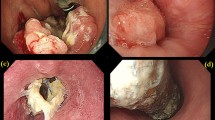Abstract
Formation of granulation tissue and stricture at the stent’s ends are well-known long-term complications of esophageal subtotally covered externally self-expandable metal stents (SEMS). Removal is associated with an increased risk of mucosal injury, severe bleeding, mediastinis, and consecutive stenosis. We report on a case of successful endoscopic removal of an esophageal SEMS 11 months after original placement to cover an iatrogenic esophageal perforation created during rigid esophagoscopy in a patient with cancer of unknown primary (CUP) syndrome. This case shows that safe SEMS late removal is achievable and at the same time illustrates the disadvantages of using SEMS for benign esophageal pathology. Particularly in cases of accidental esophageal injury during endoscopy, esophageal SEMS placement should be considered as a therapeutic option only if conventional surgery is contraindicated.





Similar content being viewed by others
References
Knyrim K, Wagner HJ, Bethge N, Keymling M, Vakil N (1993) A controlled trial of an expansile metal stent for palliation of esophageal obstruction due to inoperable cancer. N Engl J Med 329:1302–1307. doi:10.1056/NEJM199310283291803
Cwikiel W, Willen R, Stridbeck H, Lillo-Gil R, von Holstein CS (1993) Self-expanding stent in the treatment of benign esophageal strictures: experimental study in pigs and presentation of clinical cases. Radiology 187:667–671
Song HY, Park SI, Jung HY, Do YS, Yoon HK, Sung KB et al (1997) Expandable metallic stent placement in patients with benign esophageal strictures: results of long-term follow-up. Radiology 203:131–136
Hramiec JE, O’Shea MA, Quinlan RM (1998) Expandable metallic esophageal stents in benign disease: a cause for concern. Surg Laparosc Endosc 8:40–43. doi:10.1097/00019509-199802000-00010
Wagner HJ, Stinner B, Barth P, Klose KJ (2000) Are covered stents really effective at closing esophagotracheal fistulas? Results of an animal study. Cardiovasc Intervent Radiol 23:291–297. doi:10.1007/s002700010071
Doniec JM, Schniewind B, Kahlke V, Kremer B, Grimm H (2003) Therapy of anastomotic leaks by means of covered self-expanding metallic stents after esophagogastrectomy. Endoscopy 35:652–658. doi:10.1055/s-2003-41509
Low DE, Kozarek RA (2003) Removal of esophageal expandable metal stents. Surg Endosc 17:990–996. doi:10.1007/s00464-002-8528-0
Baron TH, Burgart LJ, Pochron NL (2006) An internally covered (lined) self-expanding metal esophageal stent: tissue response in a porcine model. Gastrointest Endosc 64:263–267. doi:10.1016/j.gie.2006.03.936
Mayoral W, Fleischer D, Salcedo J, Roy P, Al-Kawas F, Benjamin S (2000) Nonmalignant obstruction is a common problem with metal stents in the treatment of esophageal cancer. Gastrointest Endosc 51:556–559. doi:10.1016/S0016-5107(00)70289-6
Chen JS, Luh SP, Lee F, Tsai CI, Lee JM, Lee YC (2000) Use of esophaectomy to treat recurrent hyperplastic obstruction caused by multiple metallic stent insertion for corrosive stricture. Endoscopy 32:542–545
Mallery S, Freeman ML (1996) Removal of an incompletely expanded ultraflex esophageal stent. Gastrointest Endosc 43:163–165
Noyer CM, Forohar F (1998) A simple technique to remove migrated esophageal stents. Am J Gastroent 93:1595
Farkas PS, Farkas JD, Koenigs KP (1996) An easier method to remove migrated esophageal stent. Chest 110:857–885
Conflict of interest statement
None
Author information
Authors and Affiliations
Corresponding author
Rights and permissions
About this article
Cite this article
Gouveris, H.T., Mann, W.J. & Lippert, B.M. Successful rigid endoscopic removal of an esophageal subtotally covered nitinol stent 11 months after initial placement. Eur Arch Otorhinolaryngol 266, 927–931 (2009). https://doi.org/10.1007/s00405-008-0746-1
Received:
Accepted:
Published:
Issue Date:
DOI: https://doi.org/10.1007/s00405-008-0746-1




